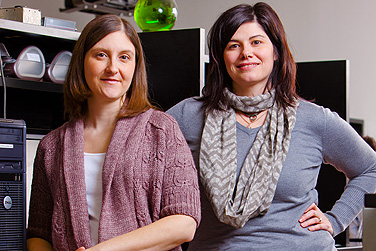News
New program takes pharmacy to next level

Erin Slazak and Nicole Albanese, clinical assistant professors of pharmacy practice, are part of a new program that helps their pharmacy students participate as integral members of health care teams in community settings. Photo: DOUGLAS LEVERE
-
 Print
Print -
 Comments
Comments
-
“We build rapport with physicians and explain how UB residents can streamline their workflow and improve patient outcomes.”
Melissa Apa gets a lower-than-expected blood sugar report back from the lab and immediately contacts her newly diagnosed diabetic patient. She wants to be sure her patient isn’t experiencing dangerously low episodes of hypoglycemia.
Apa isn’t a physician, but she is part of a growing trend in primary care. A licensed clinical pharmacist, Apa is working at the Buffalo Medical Group as part of a pharmacy practice residency offered by the School of Pharmacy and Pharmaceutical Sciences.
The UB pharmacy residency programs place students in community agencies, teaching them to function as members of health care teams who follow and interact with patients as they adjust to new diagnoses.
“We build rapport with physicians and explain how UB residents can streamline their workflow and improve patient outcomes,” explains Nicole Albanese, clinical assistant professor of pharmacy and the residency program director at the Buffalo Medical Group.
“At the Buffalo Medical Group, for example, we attend the physicians’ quarterly meetings to present health outcomes for their patients as a result of residents’ interventions.”
The appreciation for programs like UB’s pharmacy practice residency within the health care community is growing, Albanese says. Moreover, it is driven by the need for patient access to primary care and by the harsh realities of pharmacoeconomics.
According to Albanese, consumers should get used to the word “pharmacoeconomics” because they’ll be hearing a lot more about it as health care costs rise. Pharmacoeconomics is the science that compares the value of one drug over another, taking into consideration a drug’s cost-effectiveness, how well it works and how well a patient tolerates a drug—all of which influences a patient’s adherence to a drug regimen.
A recent federal Health Resources and Services Administration report found that as the population ages, it needs more complex treatment and medication regimens. This requires educated providers who are able to manage the vagaries of drug-related issues.
This also requires additional time with patients. Furthermore, the expanding need cannot be filled by primary care physicians alone, Albanese says.
Indeed, pharmacists, with their unique understanding of pharmacology and patient care, have been identified as health care providers who can address this need—improving health outcomes, creating a better quality of life for patients and lowering health care costs.
Working closely with patients’ physicians, UB pharmacy practice residents meet with patients, talk to them about their conditions, teach them how to administer their medications and follow their progress.
For example, Apa teaches patients how to test blood sugar, how to administer insulin and how to count carbohydrates. She calls patients monthly to evaluate the last several weeks of blood sugars, possibly making recommendations about the adjustment of insulin doses.
Other UB pharmacy residents perform similarly with patients who are being treated for hypertension, thyroid disease, HIV/AIDS and psychiatric disorders.
Erin Slazak, clinical assistant professor of pharmacy practice, is the program coordinator of the MedSense℠ Pharmacy Program and director of the UB residency program at Lifetime Health Medical Group—a primary care group with four practices in Western New York.
Slazak mentors UB pharmacy residents who help patients manage cholesterol, blood pressure and type 2 diabetes, among other chronic medical conditions. “I love what I do. It serves a definite need,” says Slazak.
Having the ability to work so closely with patients, helping them to adjust to their physician-prescribed treatment regimens, often leads to better compliance and improved laboratory results, Slazak says.
Such results are important to insurance companies, too. Studies from the journal Pharmacotherapy, the National Institutes of Health cholesterol guidelines and the BMJ (British Medical Journal) have concluded that reducing a patient’s laboratory numbers can be cost saving. Respectively, it is estimated that a decrease of 1 percent in the A1c, a blood test that can measure average plasma glucose over three months, may save $820 in health costs. A decrease in “bad” cholesterol, or LDL, by 1 percent may save $256. And every point that blood pressure decreases saves $9 dollars.
“Our residency programs show that patients who previously would be thought of as noncompliant often need more human intervention, more follow-up. Sometimes people who appear uninterested are just overwhelmed with a new diagnosis and really need our guidance to help them manage the details,” Albanese says.
The UB pharmacy practice residency programs are located in pharmacies, in ambulatory health agencies and in hospitals across Erie and Niagara counties. UB pharmacy residents also receive an academic appointment and are expected to teach classes at UB in the area of their residency.
“These residencies are for pharmacists who want more direct contact and involvement with patients in an ambulatory setting. They can have a real impact on a patient’s quality of life—and that’s priceless,” Albanese says.

Reader Comments